Industry outlook: Compact tool carriers equal compact versatility
Compact tool carriers offer rental centers the ability to supply a machine that can mechanize some otherwise very laborious jobs.
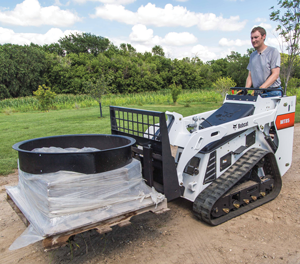 |
| Compact tool carriers often feature stand-up operator platforms, making them easy machines to mount and dismount. |
Their relatively lower initial purchase price means they can quickly pay their own way and offer promising returns. Also called mini track loaders or mini skid steers, industry experts share the best ways to use these tools and capitalize on them in rental firms.
Versatility rules
 |
| Chris Austinson, product specialist, Bobcat Company |
With their compact size and power, mini track loaders can be used in many different applications, which makes them a great fit for construction rental operations. They round out rental fleets because they have great versatility with the wide variety of attachments that can be used with them. They are a natural complement to larger skid steer and compact track loaders, working where the larger counterparts can’t because of space limitations.
Mini track loaders serve many different types of market segments and applications. Contractors operate mini track loaders to perform demolition tasks, carry pallets of building materials, or lift and carry items with a grapple. A landscaper might rent a mini track loader to prep a new yard with a soil conditioner or use a trencher to install an underground irrigation system. Tree service companies can remove stumps with a stump grinder or plant new trees with an auger.
We see a very high adoption rate for the mini track loader in rental operations. Rental operations opt for these machines because overhead on attachments is much less than on the machines themselves. So, if a rental center has multiple attachments, they open opportunities to rent the mini track loader to many different types of contractors.
The ease of transporting mini track loaders also makes them very popular for rental centers. Being a smaller machine, customers can load and transport them easily and safely. The smaller size is also beneficial when transporting because a contractor can rent the machine along with a few attachments and carry everything on one trailer, making it easier to get to the job site with fewer trips.
The most apparent limiting factor to using a mini track loader would be the rated operating capacity. They cannot lift what a larger loader might be able to lift because of their compact size. Customers continue to ask for mini track loaders with greater lift-and-carry capabilities to meet their changing job site needs and the industry is responding to them.
Renters like the units and the most common attachments used with mini track loaders include buckets, pallet forks, augers, grapples and trenchers. Many of these attachments replace work that was previously done by hand. This makes the units attractive to a contractor who is trying to complete tasks faster, and it is great for rental centers because an attachment may pay for itself after only a few rentals because of increased usage rates.
Mini track loaders really sell themselves with their compact size, performance and attachment versatility. Contractors are familiar with the machines and realize the benefit of renting mini track loaders instead of finding, scheduling, and paying additional laborers to do many of the same tasks. With a smaller pool of qualified laborers available today, these machines have never been more important to contractors.
A mini track loader can stand on its own on the job site by performing many tasks like backfilling or drilling holes for posts or trees. At the same time, it can help companies finish jobs faster. For example, a company might rent a compact excavator and rent a mini track loader to make a job go twice as fast. The mini track loader can help backfill trenches, carry pallets or even dig trenches for underground irrigation systems.
Attachments multiply jobs
Many rental operators are turning to mini skid steer machines for various landscape and
 |
| Chris Thompson, Ditch Witch product manager, mini-skid steers |
irrigation tasks and jobs. These units help fill a variety of needs in these rental operations as the machines continue to evolve and can handle a wide range of projects on a variety of jobsites.
Offering multiple attachments, the units help save time and money for jobs that required multiple pieces of equipment in the past – a big draw for today’s rental centers and rental operators. The Ditch Witch SK1550 mini skid steer can even support the work that was typically better suited for larger, traditional skid-steer loaders, including sod transfer and tree handling.
Rental operators are turning to mini skid steers. For example, landscapers need to get on and off the machine multiple times throughout the day. Hopping on and off an operator’s platform of a mini skid steer is much
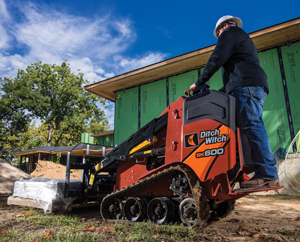 |
| Offering multiple attachments, mini skid steers help save time and money for jobs that required multiple pieces of equipment in the past – a big draw for today’s rental centers and rental operators. |
easier than climbing in and out of the cab of a larger machine. Plus, the compact units fit easily through standard yard gates where other machines may not.
The rental industry has moved past the early adoption phase and mini skid steers are becoming a staple in rental stores. Rental users are now asking for these machines by name and fully understand the versatility that allows them to do more with less.
While each machine has limiting factors based on its varying horsepower and lift capacity, the best feature of the Ditch Witch SK family of mini skid-steers is their versatility. Where one Ditch Witch unit drops off, the next unit picks up, providing full coverage for the entire market.
Mini skid steers offer dozens of attachments to help perform multiple jobs, including trencher, bucket, pallet fork, plow attachments and more. Bucket attachments are most common due to their versatility and range of applications. Recently, there has been a rise in construction attachments, such as the Ditch Witch MT9 microtrencher attachment for utility installation and the MTC100 coring attachment for utility repairs under roadways and sidewalks.
New mini skid steer attachments continue to come to the rental market. For example, today, stump grinders are successfully being fitted to these machines. The compact units can fit through gated areas and fit into backyards that aren’t accessible to larger pieces of equipment that would handle stump-grinding tasks in the past.
The newest innovation from the Ditch Witch organization is the industry-first MT9 microtrencher attachment. To help meet the needs of the growing fiber-installation trends, the attachment is designed to improve productivity and reduce cost-per-foot on small fiber job sites. The MT9 attachment is designed to work specifically with the Ditch Witch line of mini skid-steers and helps operators easily navigate in confined, tight and urban sites. It provides a narrow, shallow cut (up to 9 inches deep and 1.5 inches wide) for installing fiber-optic cables in residential areas without disrupting surrounding utilities. It excels in tight, confined areas, such as street crossings.
Additionally, Ditch Witch recently partnered with Utilicor Technologies. The new Utilicor MTC100 coring attachment works exclusively with Ditch Witch mini skid steers to help reduce costs and disruptions on utility repairs under roadways and sidewalks.
Rental companies should position the mini skid steer as the go-to machine for almost anything – it’s a do-everything machine. Whether you need to trench to help install a water line, then need to turn around and move material, or if you want to final grade; these machines can do it.
Compact tool carriers solve problems
The compact toolcarrier equipment class was well-received by the rental market shortly
 |
| Sean O'Halloran, toro marketing manager |
after this equipment became readily available. The booming popularity of the compact tool carrier in recent years is due to a few key factors, including overall growth of the rental industry, the increased willingness of contractors to consider alternative equipment and the notable increase in capabilities and rated operating capacities of the compact toolcarrier class itself.
The rental industry has seen out-standing growth over the past 10 years, and this has been driven in part by a number of new customers who
are willing to try new equipment solutions to accomplish their tasks. This new generation of rental store customers includes resourceful problem-solvers who are willing to think outside the box when it comes to their equipment. That has helped position compact tool carriers as a legitimate, lower-cost alternative to skid-steer loaders or track loaders.
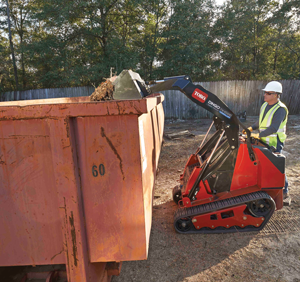 |
| The parallel lift design of the Toro Dingo allows it to reach over taller wated receptacles and dump truck beds. |
Finally, compact tool carriers can do more than ever before in terms of new technologies that have been engineered into the compact tool carrier class to support the increased interest in this kind of equipment.
Currently, there are a few manufacturers who are dedicated to developing the compact tool carrier class into one that can rival the operating capacities of skid-steer loaders. Toro, for example, recently launched the Dingo TX 1000 wide-track model, which has a rated operating capacity of 1,075 pounds. This unit outlifts some smaller skid steers, while still providing the benefits of a smaller, more budget-friendly machine. The TX 1000 unit is providing increased rated operating capacities (ROC) through the integration of vertical-lift loader arms. This design keeps the load closer to the machine, boosting overall ROC and extends reach at the maximum lift point.
Over the past decade, compact tool carriers have carved out a niche in the rental industry, and are building a reputation as being versatile, cost-effective and increasingly powerful. Because of these reasons, the compact tool carrier equipment class will continue to be a major player in the rental industry.
Rental operations have taken to the equipment class quickly, and compact tool carriers are becoming a staple product for many rental stores around the country. They have grown in popularity for a few key reasons, but probably the main reason is the fact that the demand is there. As a result, rental store owners have looked for solutions to best serve their customers and the compact tool carrier is quickly becoming an outstanding alternative to the bulkier and more expensive skid-steer loader or track loader.
There was a time when compact tool carriers were simply not even close to being able to lift as much as entry-level skid-steer loaders, but those days are far behind us. In addition to being able to lift more, compact tool carriers are simple to use and provide a better vantage point from the machine.
The limitations of these machines are few, but there are some instances in which a skid steer loader or a track loader would make more sense. For instance, they are not ideal for operation in inclement weather. Compact track loaders and skid-steer loaders feature enclosed and sometimes climate-controlled cabs, that’s not practical on a compact tool carrier. If operating in extreme conditions, like snow, rain or even excessive heat, rental store customers may be more interested in an enclosed skid-steer loader. Also, if the rental store customer knows they will need to lift more than 1,000 pounds consistently for the specific task, a compact toolcarrier may not be the best option, and rental stores should suggest a skid steer loader or track loader.
The most common attachments are bucket attachments for hauling large amounts of material, grapple rakes for handling and hauling brush and other debris, auger attachments for digging holes for planting trees or digging post holes and trencher attachments for small-scale utility or telecommunications installation.
The real beauty of the compact tool carrier is the versatility of the machine and being able to turn a single unit into a machine that can perform a variety of different tasks, depending on the attachment. Toro offers more than 35 different attachments for the Dingo, effectively transforming the machine into something new with a simple change out of attachments.The needs of a rental store customer are varied, so it’s important to stock a variety of compact tool carrier attachments to make sure there is a solution for every customer’s needs. Unique attachments, such as cement bowl mixers, vibratory plows and bore-drive head attachments can meet specific needs; Toro even offers a backhoe attachment, which effectively converts a compact toolcarrier into a mini excavator for small-scale earthmoving projects.
Rental stores should position the compact tool carrier to their customers as a viable alternative to skid-steer loaders and compact track loaders. With the recent advances in this equipment class, rental stores can point out that compact tool carriers can perform just as well as entry-level skid-steer loaders and the rental rate will likely be far less than that of a skid steer.
By helping customers figure out the ideal equipment solution and ultimately saving them money, the rental store can ensure those customers will continue to come back for all their equipment rental needs.
Growing in popularity
 |
| Alex Berg, Triple E Equipment tresident/CEO |
Compact tool carriers are becoming a necessity on every job site throughout the world. Much like how the mini excavator is now seen on projects big and small, compact tool carriers are being used to perform a wide variety of daily tasks in a wide range of project sizes.
From moving small materials with a pallet fork attachment and cleaning rubble with a bucket, to drilling holes with an auger or sweeping a floor with a rolling sweeper, compact tool carriers can complete a wide range of tasks while reducing labor costs and increasing jobsite safety. Gasoline- and diesel-powered units are great for exterior applications, while battery-powered units can work indoors that previously could not be accessed by fume-producing machines.
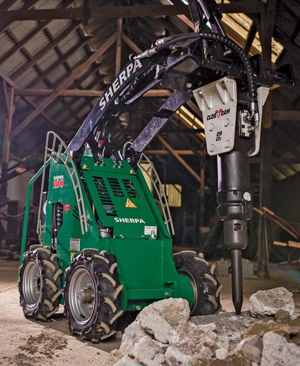 |
| The electric-powered Sherpa 100 can operate in encloed environments without the risk of toxic emissions. |
Rental operations have been carrying compact tool carriers for several years and recently started adopting the newest technology of battery power. Typical gas- and diesel-powered compact toolcarriers are very prevalent throughout the industry, while battery-powered units are starting make their mark with the push for more environmentally energy-efficient products.
Whatever the power source may be, compact toolcarriers have the added advantage of being able to perform a variety of tasks in tight quarters with different attachments. Rental operations understand that they can reach a variety of customers by providing one unit with many capabilities.
While compact toolcarriers are very powerful and capable machines compared to a labor force, they don’t readily compare to larger full-sized skids steers that are better suited for large projects. Compact tool carriers are small and maneuverable, but lack the horsepower and torque that larger machines have. Battery-powered compact tool carriers are at an advantage while performing work indoors because of the small size of the machine. They can easily access smaller areas and complete work more profitably with lower risk to workers.
There are a wide range of attachments available for compact tool carriers to complete almost any task. For landscapers, anything from grapple buckets and pallet forks to augers and trenchers are available. For a contractor, simply attach a hydraulic hammer or rolling sweeper for cleanup. As long as there is a hydraulic auxiliary function, which is standard on most compact tool carrier models, the options are endless for attachments.
One of the newest attachments we have seen recently is a vacuum system that allow for lifting slabs without setting anchor bolts. Workers simply use the suction power to securely lift and move a product from one area to another. This comes in handy when removing concrete from an interior area to an exterior area.
Rental centers and rental operators have done an excellent job of promoting the use of compact toolcarriers throughout the industry. By highlighting the multifunctionality of the machine, potential customers see that while they thought they could only use the unit for one task, there is a wide range of other tasks that can be completed by changing the attachment.
This phenomenon has taken off with battery-powered compact tool carriers as customers are using a specific attachment for on outdoor application and then changing the attachment so the unit can be used in an indoor application.
Becoming a must-have tool
 |
| Jason Showers, Boxer product manager, Morbark LLC |
Compact tool carriers have become formidable pieces of equipment over the past decade and continue to make an impact as awareness and capabilities rise.
Compact tool carriers have an increased role in the rental and contractor markets. Since their debut in the United States, these units have grown from the perception of a toy or gimmick unit to a must-have tool for contractors and rental customers.
These units have grown in capacity, capability, size and versatility. With more than 50 base attachments, the compact units can achieve workloads upward of 80 percent of their full-sized counterparts.
These compact, yet powerful machines allow operators some significant advantages in operation, such as clear line of sight to the attachment, unobstructed visibility of the work area, easy on/off access, smaller footprint for reduced ground disturbance and physically smaller size to work in tighter, more confined spaces.
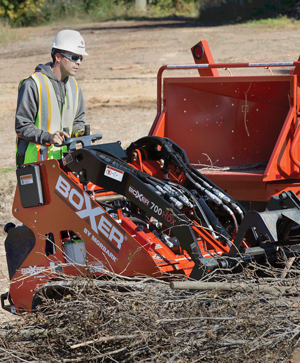 |
| Boxer offers more than 50 attachments that can be paired with its compact tool carrier to simplify a wide variety of jobs. |
For contractors, logistics may improve with a smaller machine as full-sized units often require a dedicated trailer for the unit or possibly an additional truck to the job site. With the smaller stature of the compact tool carrier, contractors can typically load the machine and attachments into a trailer already being hauled to the job site, potentially reducing logistics costs and improving bottom-line performance.
Rental customers and contractor customers often work hand-in-hand. Either the contractor started renting the unit and attachments, or the contractor may rent specialty attachments from the rental agency to reduce overhead.
Rental customers have adopted compact toolcarriers as a staple in their rental fleets, especially since the units have grown in size, usefulness and performance.
All machinery comes with limitations and contractors and operators need to take care in the equipment selection process. Navigating all of the specifications encountered when making an equipment selection can be tricky and it is important the contractor selects the right piece of equipment for the job and not necessarily just what fits within the budget.
While budget is an important consideration, allocating additional funds toward the right equipment could pay dividends down the road. If concessions need to be made to fit within the customer’s budget, the decision could come back to continued rental or rental/purchase of a larger machine until the budget allows the purchase of the desired machine for the job, or simply purchasing a good used piece of equipment.
Some important factors to take into consideration when purchasing a compact tool carrier is to understand the job that is being performed and base your equipment selection from there. Considerations such as lift height, operating capacity, auxiliary hydraulic flow, operator ergonomics that include operator comfort and attachment line of site and whether a ride-on or walk-behind unit is desired play a role in the selection process.
Also, it is important to determine an equipment life-cycle plan, such as how long you plan to keep the unit vs. what your future plans are for the equipment three to five years down the road. The contractor should determine if the machine being purchased today fits their vision a few years down the road to ensure
maximum return on their investment. If the answer is yes, then they can confidently move forward. If the answer is no, there may be additional questions that will need to be
answered to make an informed equipment purchase.
When customers are looking to purchase a compact tool carrier, we encourage them to focus on the attachments needed. The most common attachments for compact tool carriers are buckets, augers, pallet forks, trenchers and hydraulic breakers. If you know and understand the job for which the machine is intended, the compact tool carrier solution will follow. Sometimes the decision is quite clear, while other times, the decision requires additional thought and consideration.
Positioning these units to stand out in a rental application can be as simple as packaging. Turnkey packages are one of the ways rental companies can set themselves apart from other rental companies. A turnkey package would include a trailer, machine and common attachments such as the auger drive, bits, pallet forks, bucket and trencher.
Compact tool carrier rental market expanding
 |
| Matt Hutchinson, Vermeer product maanger for tree care, rental and landscape |
Mini skid steers aren’t new to rental companies, but in the last couple of years there has been a shift in what these compact machines can do. Mini skid steers are getting more powerful. They are able to lift more and lift higher, which opens the possibility to serve a wider range of rental customers.
Mini skid steers used to only be promoted as a replacement for hand labor, primarily serving landscapers. Since entering the market, Vermeer has been dedicated to growing the segment. We’ve added power and capacity so operators that’s ideally suited for the variety of applications.
Mini skid steers don’t just perform one task on a job well; they can do a great job on the whole project. For example, a mini skid-steer loader paired with a hydraulic breaker attachment can be taken through a narrow entryway and outperform a traditional jackhammer and air compressor. Plus, contractors can easily and quickly haul the debris away by switching to a bucket attachment. Because some larger mini skid steers offer higher lift capacities, the operator can easily load the material into the back of a dump truck.
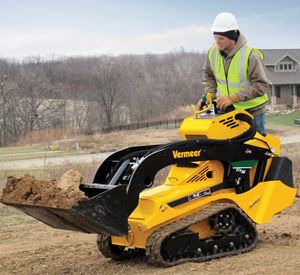 |
| Mini skid steers used to only be promoted as a replacement for hand labor, primarily serving landscapers. Since entering the market, Vermeer has been dedicated to growing the segment. |
Another key difference in today’s mini skid steers is their hydraulic performance. Hydraulic flow affects the machine’s breakout force and the performance of several attachments that require high-flow auxiliary hydraulics. Today’s mini skid steers can be outfitted with a bucket for digging instead of just loading material. They can also be more efficient using attachments like tillers, harley rakes and hydraulic breakers — attachments that were once only productive with a larger tool carrier.
For rental companies to maximize their investment in mini skid steers, they need to be aware of the different applications where they excel. That means rental centers need to think beyond landscapers to demolition, general construction, tree care and more. Rental operations also need the attachments required for these types of jobs. That shouldn’t be too much of an issue because mini skid steers can usually share the same Vermeer-approved attachments used on smaller skid steer loaders.
To best leverage this equipment, representatives must take the time to talk with their customers. Most contractors don’t ask rental representatives for advice on what equipment they need to accomplish a certain job, which makes it challenging to recommend an alternative solution. Savvy rental company representatives will dive deeper into the type of work a customer is doing so they can make a recommendation on the next job.
Understanding the needs of customers is the first step in positioning mini skid steers to a
wider audience. Next, it’s making sure the rental operation has the appropriate size mini skid steer and the right attachments to appeal to a market. While all of these machines are compact, there is a difference between models, and certain markets are going to prefer a certain size and type of machine. Smaller units are going to appeal more to landscapers and contractors, while some of the larger ones are going to be better suited for contractors doing demolition, tree care, digging and other larger chores.
Copyright November-December 2017 issue of Pro Contractor Rentals magazine. All rights reserved.









